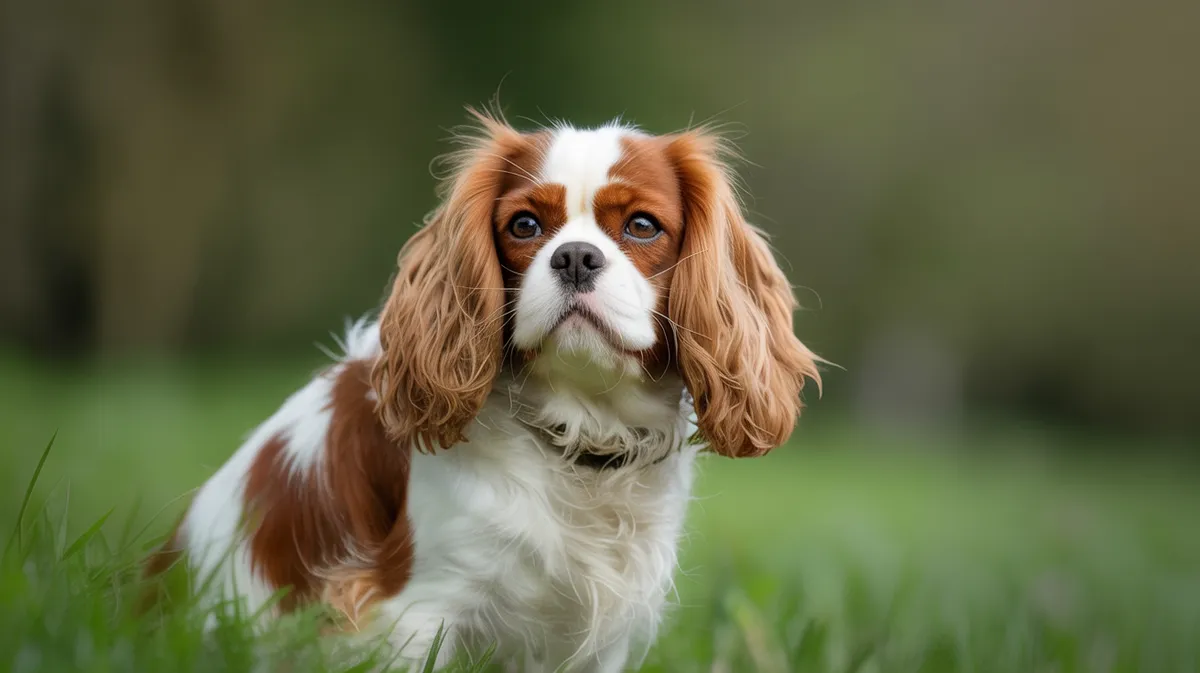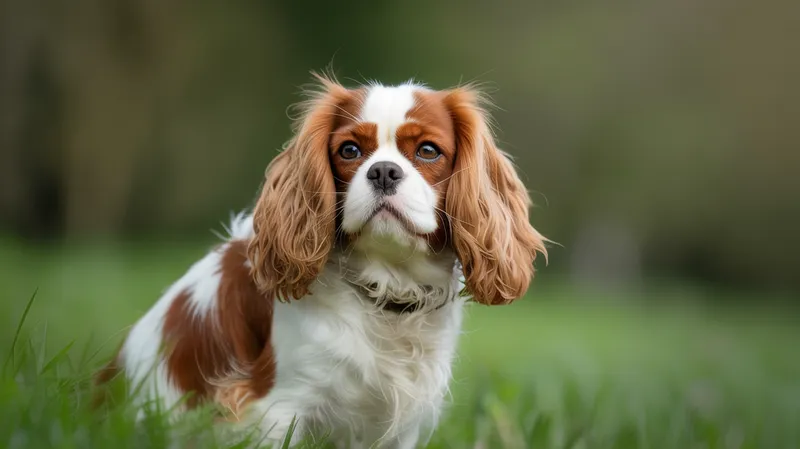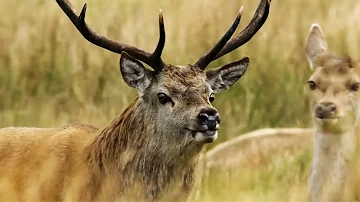
Cavalier King Charles Spaniel
Canis lupus familiaris

Meet the Cavalier King Charles Spaniel
The Cavalier King Charles Spaniel is a small, elegant toy breed known for its expressive, large dark eyes and silky, feathered coat. Originating in the United Kingdom, this breed was a favorite among royalty and aristocracy, especially during the reign of King Charles II. Cavaliers are affectionate, sociable, and gentle, making them excellent companion animals. They adapt well to various living environments and are known for their friendly nature toward children and other pets.
Classification
Mammal
Habitat
Domestic
Diet
Omnivore
Lifespan
9-15 years
Conservation
Least Concern
Weight
5.9–8.2 kg (13–18 lbs)
📖Fascinating Facts
Royal Favorite
Cavalier King Charles Spaniels were named for King Charles II, who was rarely seen without at least two or three of these dogs at his side.
Distinct Color Varieties
The breed is recognized in four color patterns: Blenheim (chestnut and white), Tricolor (black, white, and tan), Ruby (solid red), and Black & Tan.
Affectionate Companions
Cavaliers are renowned for their loving, gentle nature and are often used as therapy dogs due to their calm and friendly demeanor.
📋Detailed Description
The Cavalier King Charles Spaniel is a compact, graceful toy breed, typically weighing between 5.4 and 8 kg (12–18 lbs) and standing 30–33 cm (12–13 inches) at the shoulder. Its most distinctive features are large, dark, round eyes set well apart, a slightly rounded skull, and a well-tapered muzzle. The breed’s ears are long, feathered, and set high, contributing to its expressive appearance. The silky, medium-length coat is straight or slightly wavy, with abundant feathering on the ears, chest, legs, and tail, and comes in four recognized color patterns: Blenheim, tricolor, ruby, and black and tan. Cavaliers have a well-developed chest and a moderately long, feathered tail that is carried happily but never much above the level of the back. Anatomically, they possess a gentle, athletic build, allowing for agility and stamina disproportionate to their size. Their cardiovascular and respiratory systems are notable for breed-specific vulnerabilities, including a predisposition to mitral valve disease. Socially, Cavaliers are highly people-oriented, forming strong bonds with humans and thriving on companionship. Their gentle temperament and adaptability make them suitable for therapy work and as emotional support animals.
💡 Did you know?
The breed’s name comes from King Charles II of England, who was so devoted to his spaniels that he reportedly allowed them to roam the royal court freely—even in Parliament.
🔬Research & Sources
Wikipedia Summary
The Cavalier King Charles Spaniel (CKCS) is a British breed of toy dog of spaniel type. Four colours are recognised: Blenheim, tricolour (black/white/tan), black and tan, and ruby; the coat is smooth and silky. The lifespan is usually between eight and twelve years.
Last Modified: 6/4/2025
🎭Behavior & Social Structure
Cavalier King Charles Spaniels are renowned for their affectionate, sociable, and eager-to-please demeanor. They display a strong desire for human interaction and are rarely aggressive, making them excellent family pets. Their behavior is characterized by a playful curiosity and a tendency to follow their owners from room to room. While not bred for hunting in modern times, they retain some spaniel instincts, such as chasing moving objects and exhibiting a moderate prey drive toward birds or small mammals. Cavaliers are generally quiet indoors but may bark to alert their owners. They are intelligent and respond well to positive reinforcement training, excelling in obedience, agility, and canine sports. Social interactions with other dogs and pets are typically harmonious, and they are known for their gentle approach to children. Daily routines should include moderate exercise, mental stimulation, and ample social contact to prevent separation anxiety and boredom-related behaviors.
👶Reproduction & Life Cycle
Cavalier King Charles Spaniels reach sexual maturity between 6 and 12 months, with most breeders recommending waiting until at least the second or third estrus cycle before breeding females. The breed is polyestrous, with females typically coming into heat twice a year. Mating is usually straightforward, but due to the breed’s small size and potential for hereditary health issues, responsible breeding practices are essential. The gestation period averages 63 days. Litter sizes range from 3 to 6 puppies, with 4 being typical. Parental care is primarily provided by the dam, who nurses and cleans the puppies for the first 3–4 weeks. Puppies are weaned gradually and begin socialization at 3–4 weeks, with breeders emphasizing early exposure to humans and gentle handling to foster the breed’s characteristic temperament. Breeding programs often screen for genetic disorders, particularly mitral valve disease and syringomyelia, to reduce the prevalence of inherited conditions.
🛡️Adaptations & Survival
The Cavalier King Charles Spaniel’s physical adaptations include a compact, athletic body that allows for agility and moderate endurance, making them suitable for both indoor living and outdoor activities. Their large, expressive eyes enhance social communication with humans, a trait likely selected through domestication. The long, feathered ears and silky coat provide some protection against environmental elements, though they require regular grooming. Behaviorally, Cavaliers have evolved a strong attachment to humans, displaying neotenic (juvenile) traits such as playfulness and dependency well into adulthood. Their gentle, non-aggressive disposition and high sociability are adaptive for life as companion animals. The breed’s moderate prey drive and alertness are remnants of their spaniel ancestry, though these traits are subdued compared to working spaniels.
📚Research Sources
🎨Cultural Significance
The Cavalier King Charles Spaniel has a storied history in British and European aristocracy, particularly during the reign of King Charles II, after whom the breed is named. They were favored as lapdogs and companions in royal courts, often depicted in paintings from the 17th and 18th centuries. The breed symbolizes refinement, loyalty, and affection, and has been associated with themes of companionship and gentle nobility in literature and art. In modern times, Cavaliers are celebrated as therapy and emotional support animals due to their empathetic nature. Their presence in popular culture, including film, television, and advertising, reinforces their status as quintessential companion dogs. There are no known traditional utilitarian uses beyond companionship, but their role in human emotional well-being is significant.
🔬Recent Research & Discoveries
Recent scientific studies on the Cavalier King Charles Spaniel have focused on the genetic basis of mitral valve disease and syringomyelia, with advances in molecular genetics identifying specific gene mutations associated with these conditions. Ongoing research aims to develop genetic screening protocols to reduce disease prevalence through selective breeding. Studies in canine cognition have highlighted the breed’s advanced social intelligence and capacity for emotional attunement with humans. Veterinary research has also explored optimal management strategies for chronic health conditions prevalent in the breed, including dietary interventions, pharmacological treatments, and surgical options for syringomyelia. Population genetics research is examining the effects of inbreeding and genetic bottlenecks, with recommendations for increasing genetic diversity in breeding programs.
🎥Wildlife Videos

Rescue Vet | S1 E8 'Cavalier' | Wild America Animal Channel
Title: Rescue Vet 'Cavalier' Summary: In this episode, a King Charles Cavalier is brought in for a followup on heart disease.
Wild America Animal Channel

Shih Tzu vs Cavalier King | Wildlife Documentary | Informative #wildanimals#wildbird#seaanimal#wild
Shih Tzu vs Cavalier King | Wildlife Documentary | Informative #wildanimals#wildbird#seaanimal#wild ...
Animals World.official

Nature Animal Cavalier King Charles Spaniel Dogs | Wildlife Animals | Birds Sound Track
Wildlife#Animal#Dogs#nature#Soundtrack# Thank you for watching my Videos. I love to create videos to show you how beautiful ...
Nature-Animals

Exploring Britain’s Wild Animals: From Golden Eagles to Goshawks (3H Marathon)
Exploring the country's diverse landscapes and the wildlife that has adapted to survive in extreme environments, from Golden ...
Our World

CAVALIER KING CHARLES SPANIEL PROs & CONs (Include Health Problems) - Must Watch Before Getting One
Welcome to Animal Digest (The Pros and Cons of Owning a Cavalier King Charles Spaniel). Cavalier King Charles Spaniels are ...
Animal Digest

Dogs 101 - Cavalier King Charles Spaniel
I do not own anything, All rights to Animal Planet.
DogLover
🌍Habitat Information
The Cavalier King Charles Spaniel typically inhabits Domestic environments. Cavalier King Charles Spaniels have adapted to their environments with specialized features and behaviors.
Primary Habitat:
Domestic
More detailed habitat information will be available soon.
🛡️Conservation Status
The Cavalier King Charles Spaniel is currently classified as Least Concern. Conservation efforts are crucial for preserving this species for future generations.
Common Threats:
- 🏠Habitat loss and fragmentation
- 🌡️Climate change impacts
- 🎯Hunting and poaching
- 🏭Human-wildlife conflict
⚠️Threats & Conservation Challenges
The primary threats facing the Cavalier King Charles Spaniel are health-related, particularly the high prevalence of hereditary diseases such as mitral valve disease (MVD), syringomyelia (SM), and episodic falling syndrome. MVD is the leading cause of death in the breed, with studies indicating that over 50% of Cavaliers develop some degree of heart disease by age 5. Syringomyelia, a neurological condition caused by skull malformation, affects a significant proportion of the population and can lead to chronic pain. Other challenges include patellar luxation, hip dysplasia, and eye disorders. Intensive breeding for appearance has exacerbated these issues, leading to calls for stricter health screening and genetic testing. While the breed is not endangered and remains popular worldwide, the focus on health and welfare is critical for its long-term viability. Human impact is primarily positive in terms of care and companionship, but irresponsible breeding practices pose ongoing challenges.
🔬Scientific Classification
Scientific Name
Canis lupus familiaris
Classification Hierarchy
🔍 About Taxonomic Classification
Taxonomic classification is a hierarchical system used by scientists to classify and organize living organisms based on shared characteristics and evolutionary relationships.
The system moves from broad categories (Kingdom) to increasingly specific ones, with each animal's scientific name typically consisting of its Genus and species.
📝Community Notes
Share your observations and insights about the Cavalier King Charles Spaniel with our community of wildlife enthusiasts.
Join Our Community
Sign in to share your observations and connect with fellow wildlife enthusiasts.
Sign In to ContributeNo community notes yet
Be the first to share your observations about the Cavalier King Charles Spaniel!
Explore Cavalier King Charles Spaniel
Select a tab above to learn more about this amazing animal.
📸Photo Gallery
No photos available for this animal yet.
🌟Discover More Wildlife
Continue your journey of discovery with more fascinating animals from our database
